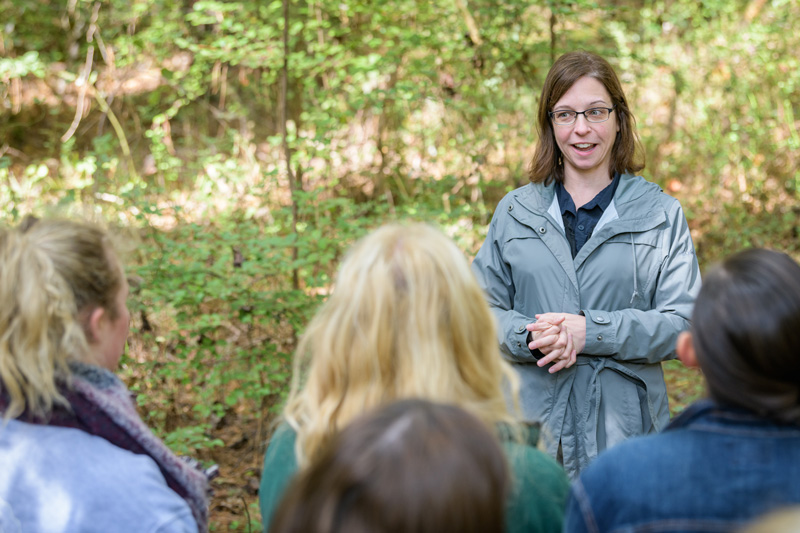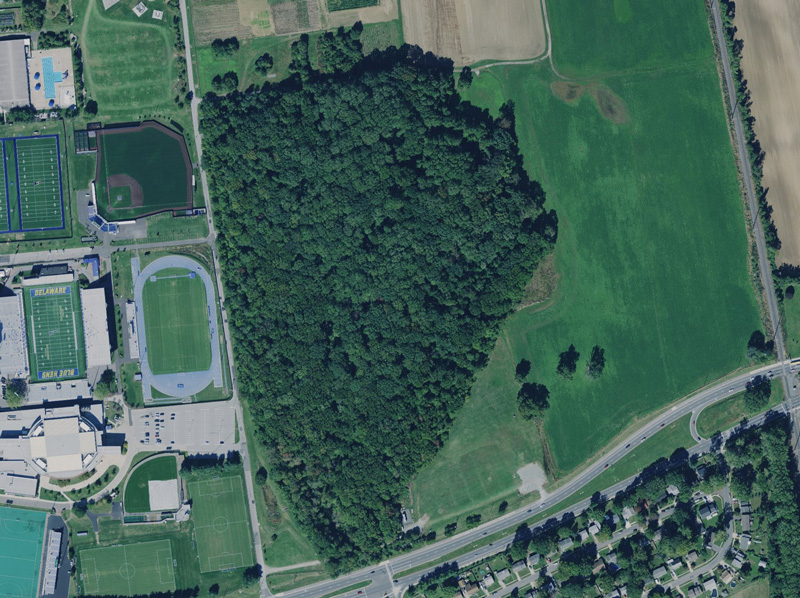


Human impact on the global nitrogen cycle
Photos by Evan Krape and courtesy of Tara Trammell November 07, 2018
UD’s Tara Trammell to study ecological effects of excess nitrogen in small forests
Nitrogen is an essential element required by all life — vital for plant and animal growth and nourishment. But, an overabundance of nitrogen can cause negative ecological effects.
Over the past century, the amount of nitrogen cycling through the environment has drastically changed with humans as the culprit.
“We’ve doubled the amount of reactive nitrogen cycling through the environment,” said Tara Trammell, the John Bartram Assistant Professor of Urban Forestry in the University of Delaware Department of Plant and Soil Sciences. “Prior to the Industrial Revolution, nitrogen would cycle tightly within ecosystems. Through human activities, we are converting inert forms of nitrogen into reactive forms, like inorganic fertilizer, that plants can use.”
Despite its critical role on Earth, our understanding of the global nitrogen cycle is far behind our understanding of the more-publicized global carbon cycle.
“Large intact forests have the capacity to store excess nitrogen, but expanding urban and suburban development has changed nitrogen dynamics in forests,” Trammell said.
The majority of temperate, deciduous forests in the U.S. are now small forest patches — more vulnerable to consequences of human activities like excess nitrogen inputs and non-native, invasive plant spread. Trammell was recently awarded a National Science Foundation grant to study nitrogen cycling in forests, specifically smaller forest patches found in suburban and urban areas.
Through the Haber-Bosch process, which received the Nobel Prize for Chemistry in 1918, humans convert atmospheric nitrogen gas into ammonia, which is used as a base for many inorganic fertilizers. Transportation exhaust creates another form of reactive nitrogen through fossil fuel combustion. These human activities convert nitrogen from inactive to reactive forms.
“Before the Haber-Bosch process and fossil fuel combustion, specialized microbes in the soil could fix nitrogen into forms usable by plants,” said Trammell, the study’s principal investigator. “So nitrogen would cycle very tightly through ecosystems. Through human activities, we are producing reactive forms of nitrogen.”
Trammell will collaborate with Phil Townsend, a professor at the University of Wisconsin-Madison, to utilize novel remote sensing techniques that enable large scale study. They’ll investigate forest nitrogen dynamics in the face of multiple global change factors, such as excess nitrogen and non-native plant invasion. The outcome of this work will provide new understanding on how tightly nitrogen cycles through canopy trees in temperate forests experiencing excessive nitrogen. Throughout the two-year study, researchers will use image spectroscopy to compare forests in rural, suburban and urban areas that are experiencing non-native plant invasion.
The majority of small forests are located in highly developed areas. These temperate, deciduous forests are in the northern hemisphere — places like North America, Europe and China. Like the U.S. East coast, these locations are also where a large portion of the global population lives.
“Forests across developed areas have experienced changing land use,” Trammell said. “Small forest patches were either remnants left intact during development or were previously used for agriculture, logging or other activities and later abandoned. These forests are highly fragmented.”
In the U.S., 92 percent of these forests are very small fragments, which may not store excessive nitrogen like large intact forests.
“Nitrogen is considered the most limiting nutrient for plant growth in temperate ecosystems,” Trammell said. “The complexity of the nitrogen cycle is a major challenge for studying the consequences of excess nitrogen on ecosystems.”
Soil processes are difficult to study in isolation. The researchers will investigate global change factors, like plant invasion and urbanization that influence how nitrogen cycles in small forest patches. The pollution caused by nutrient export into waterways is a primary concern.
“In our region, it’s critical to control eutrophication [excessive richness of nutrients in a body of water] of waterways like the Delaware and Chesapeake bays,” Trammell said.
The process results in oxygen depletion, which causes major problems for marine life, like fish kills and human health, like drinking water pollution.

Contact Us
Have a UDaily story idea?
Contact us at ocm@udel.edu
Members of the press
Contact us at 302-831-NEWS or visit the Media Relations website

